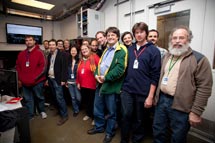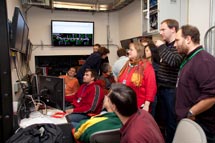
Handy Links
SLAC News Center
SLAC Today
- Subscribe
- Archives: Feb 2006-May 20, 2011
- Archives: May 23, 2011 and later
- Submit Feedback or Story Ideas
- About SLAC Today
SLAC News
Lab News
- Interactions
- Lightsources.org
- ILC NewsLine
- Int'l Science Grid This Week
- Fermilab Today
- Berkeley Lab News
- @brookhaven TODAY
- DOE Pulse
- CERN Courier
- DESY inForm
- US / LHC
SLAC Links
- Emergency
- Safety
- Policy Repository
- Site Entry Form

- Site Maps
- M & O Review
- Computing Status & Calendar
- SLAC Colloquium
- SLACspeak
- SLACspace
- SLAC Logo
- Café Menu
- Flea Market
- Web E-mail
- Marguerite Shuttle
- Discount Commuter Passes
-
Award Reporting Form
- SPIRES
- SciDoc
- Activity Groups
- Library
Stanford
Around the Bay
Launch of Fourth LCLS Instrument Reveals Crisp, Fine Molecular Detail
The first set of user experiments with the Linac Coherent Light Source's newest instrument is under way, and about 40 researchers are working very long hours this week to decipher the structures of proteins involved in photosynthesis, parasitic disease and other important life processes.
The results won't be known for months, after extensive analysis of the data. But near the end of the second 12-hour shift on Tuesday morning, scientists gathered in front of a bank of computer monitors in the CXI control room were beaming and pointing at the screens, to a chorus of "oohs" and "ahhs."
"You see this protein, all these rings here?" Petra Fromme of Arizona State University asked me, pointing to a printed image of what looked like tiny, bright stars arranged in circular patterns against a dark sky. "What's really nice is that each spot is so very fine. The diffraction pattern is so much cleaner" than the ones obtained with traditional structural analysis. What that implies, at a preliminary glance, is that the team may have captured the structure of a photosynthetic protein complex in very fine, crisp detail, approaching atomic resolution.
The LCLS is the world's most powerful X-ray free electron laser. Its strobe-light pulses—120 of them per second—could burn through steel, yet they're so brief that they can hit a fragile biological sample and form the diffraction patterns needed to make an image before the sample explodes.
CXI, the Coherent X-ray Imaging instrument, is the fourth instrument to get up and running since the LCLS opened for research in 2009, and the second to operate at "hard" X-ray wavelengths. Hard X-rays are more energetic than the soft X-rays used previously in similar experiments, so they penetrate deeper into samples and should yield images with higher resolution. These qualities make them ideal for biological studies of everything from crystallized proteins to viruses and intact living cells.
The 40-member international research team, led by principal investigator Sebastien Boutet of SLAC, was originally scheduled to perform this one-week run of experiments on the X-ray Pump Probe instrument, XPP. At the time the schedule was drawn up it was thought that CXI would not be ready yet; so the plan was to move some of the CXI equipment, including a 1,400-pound detector chamber, over to the XPP hutch, hook it up and collect the protein data there.
"But we all concluded it would be an even bigger risk to take the stuff from CXI to XPP" and install and test it there, said Boutet, who is a CXI instrument scientist. So the experiments were moved to CXI, which had undergone only nine shifts' worth of commissioning—the preliminary phase of testing and calibration in which bugs in the software and equipment are worked out. As of Tuesday morning, the strategy appeared to be paying off.
"The first shift was a bit of a struggle," Boutet said. But after getting some sleep, he said, people came back with ideas for improving the next run, and "last night we got lots of data. We ran samples for long periods of time and got very good-looking data for a number of hours."
The team is also aiming the LCLS beam at an enzyme that breaks down proteins, from the parasite that causes African sleeping sickness. Deciphering its structure would be an important step toward designing a drug to block its activities and stave off illness, said team member Lars Redecke of the Universities of Hamburg and Lübeck in Germany.
In each case, the proteins were turned into much smaller crystals than the ones used in traditional X-ray structural analysis, then squirted into the path of the X-ray laser beam. These nanocrystals, which each contain a few thousand copies of the protein molecule, are a lot easier to prepare than the bigger ones, and offer a new way to analyze proteins that are difficult or impossible to crystallize. A team that included many of the same researchers had demonstrated that the technique worked in a series of December 2009 experiments with the LCLS's Atomic, Molecular and Optical Science instrument; now they want to do the same thing with the CXI to resolve protein structures in much more detail.
This new round of experiments started at 9 p.m. Sunday, ran overnight, and picked up again on 9 p.m. Monday. But that's just the official schedule, said Andrew Aquila of the Center for Free-Electron Laser Science at the German national laboratory DESY.
"They give us 12-hour shifts," he said, "but we come in early to set up and prepare samples for analysis." When the shift is over, researchers often stay on to look at the data they just gathered, make sure they've collected enough information on one sample before moving on to the next, and so on, he said.
Despite the grueling schedule, the bleary-eyed researchers seemed to be enjoying themselves.
"It's going very well," said SLAC staff scientist Marvin Seibert, grinning. "The fireworks are back. It's always fun."
—Glennda Chui
SLAC Today, February 16, 2011

